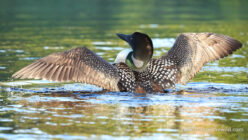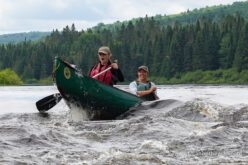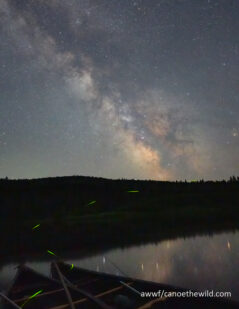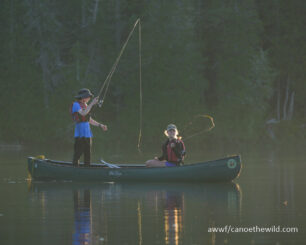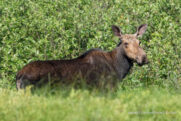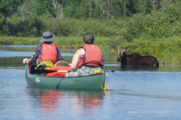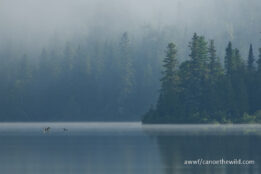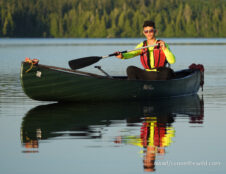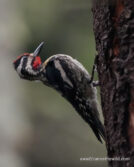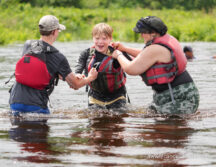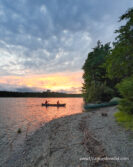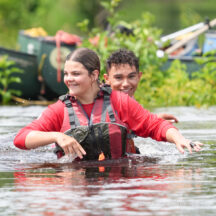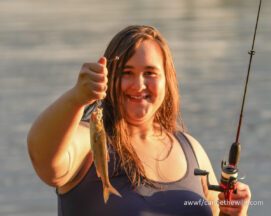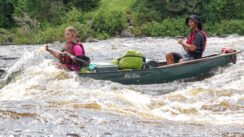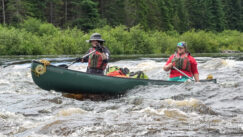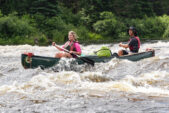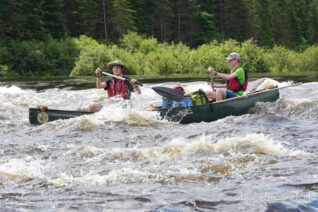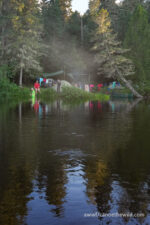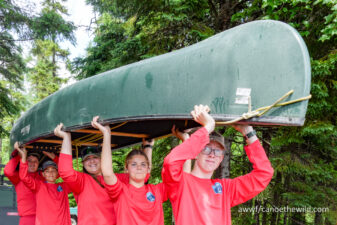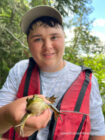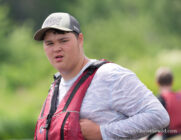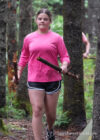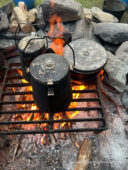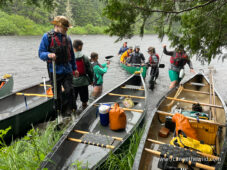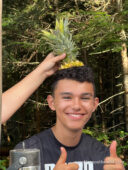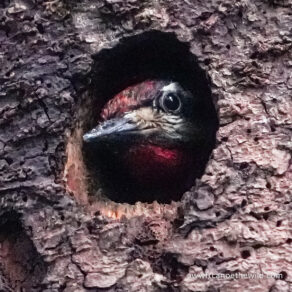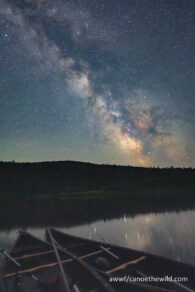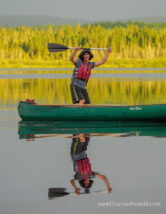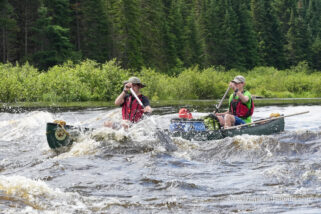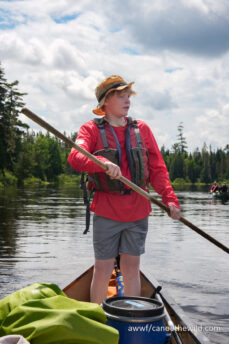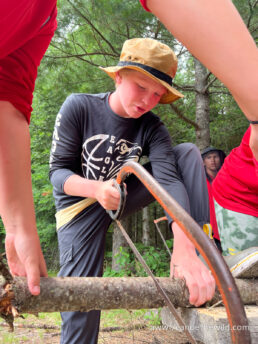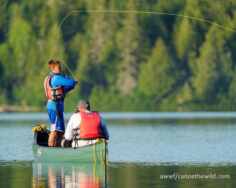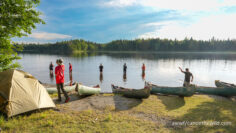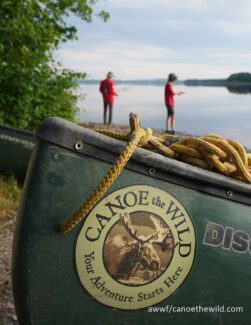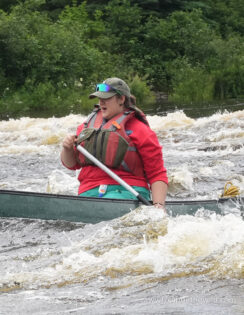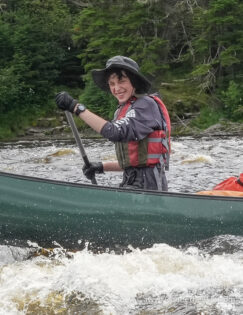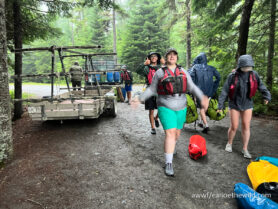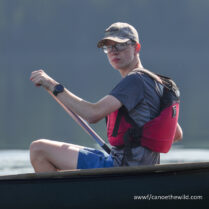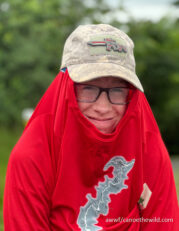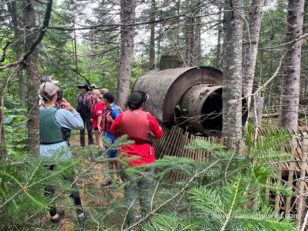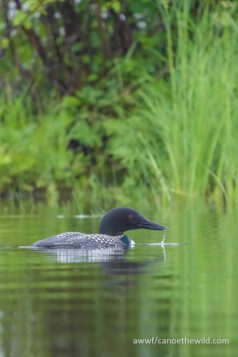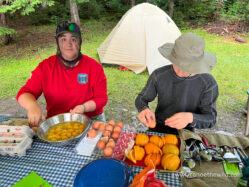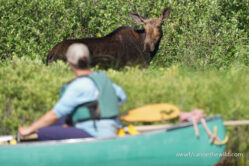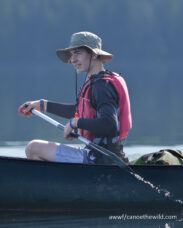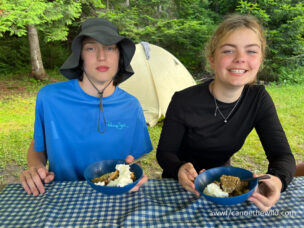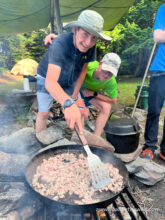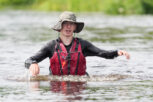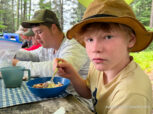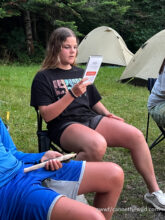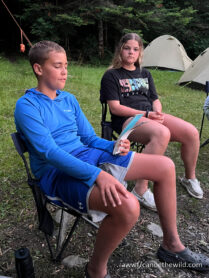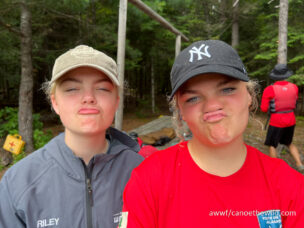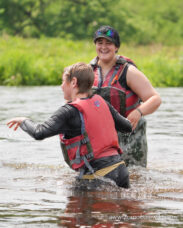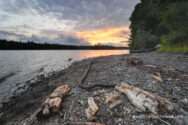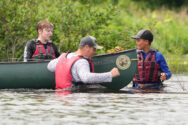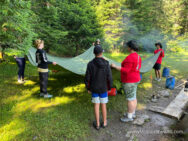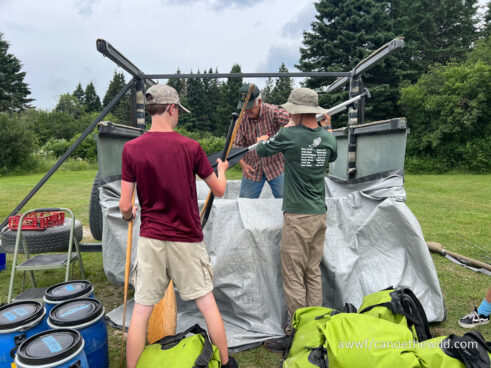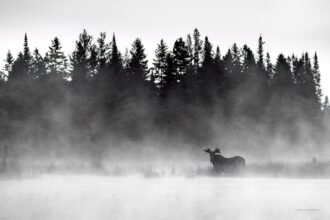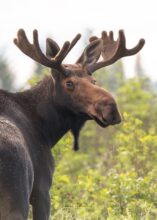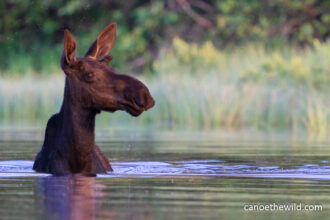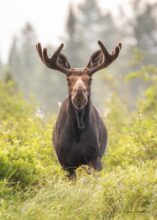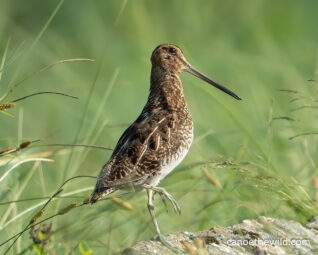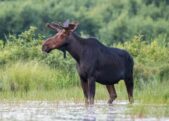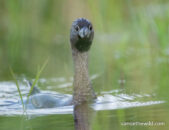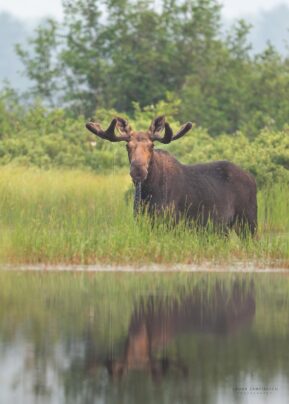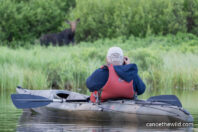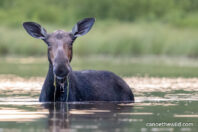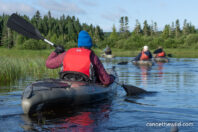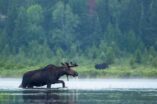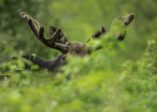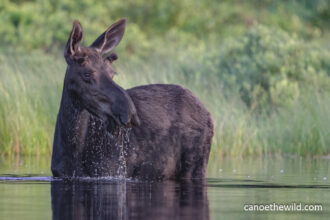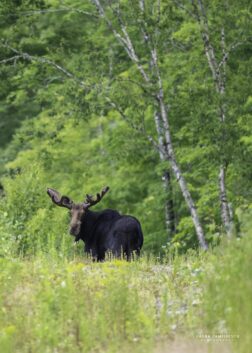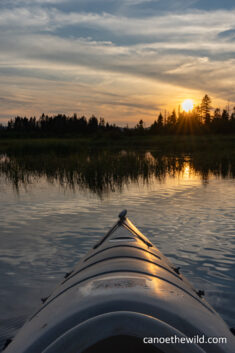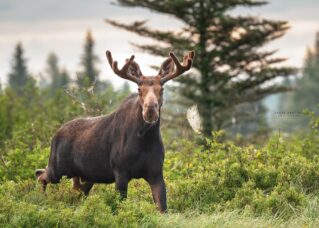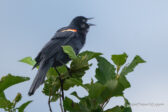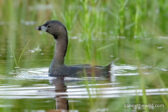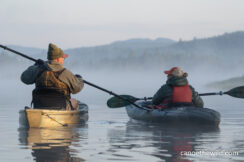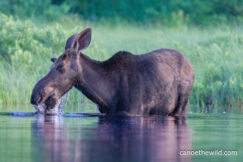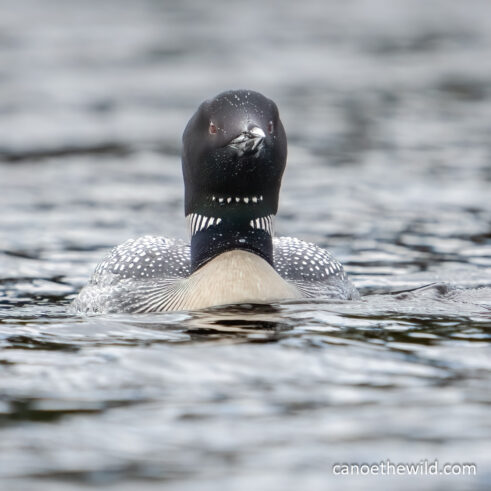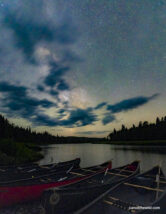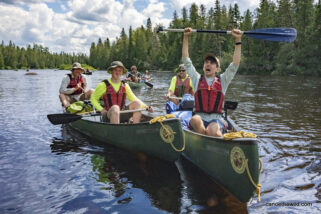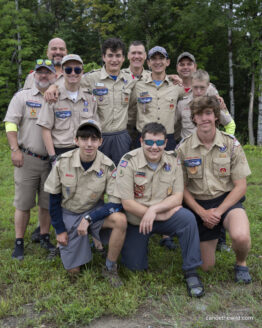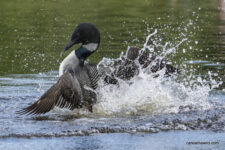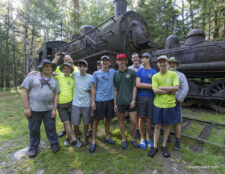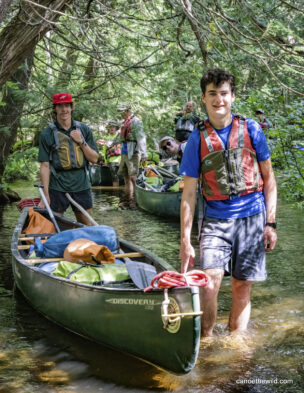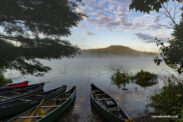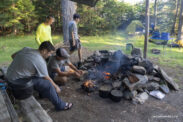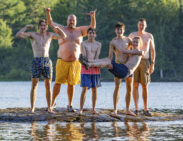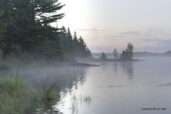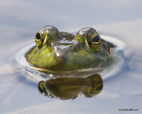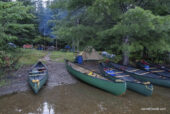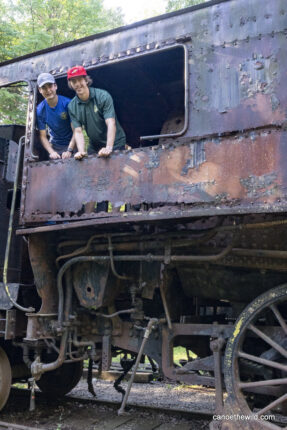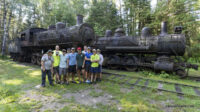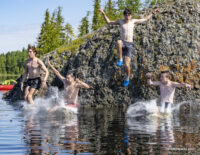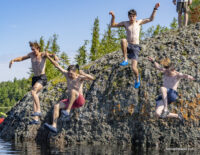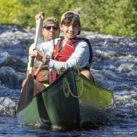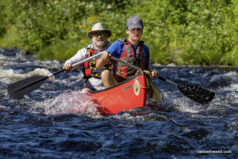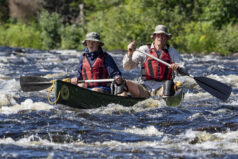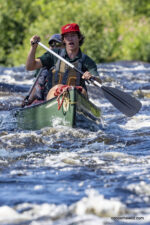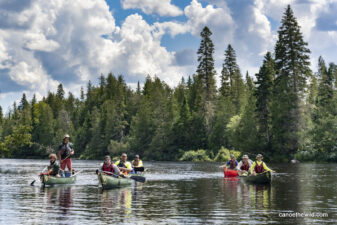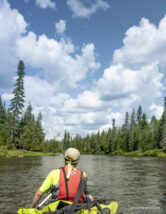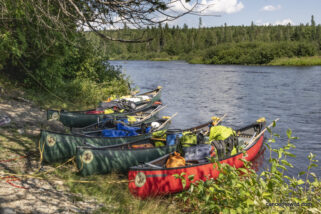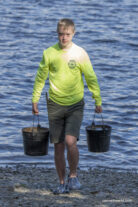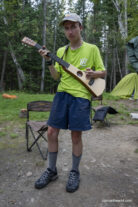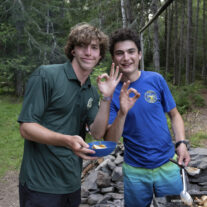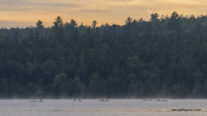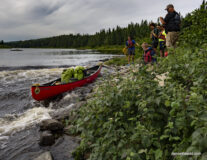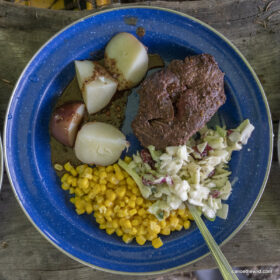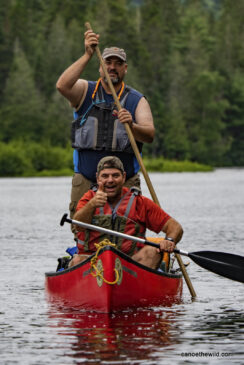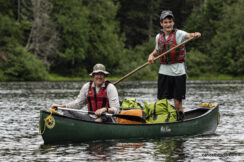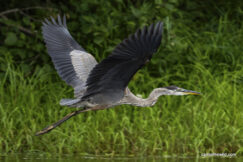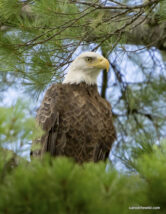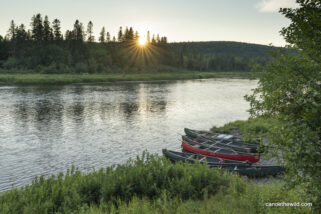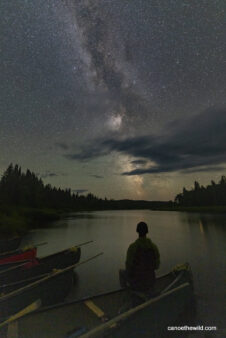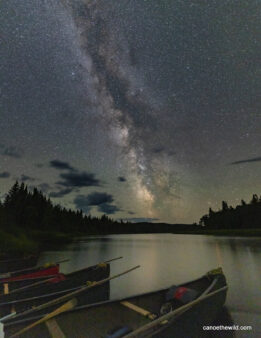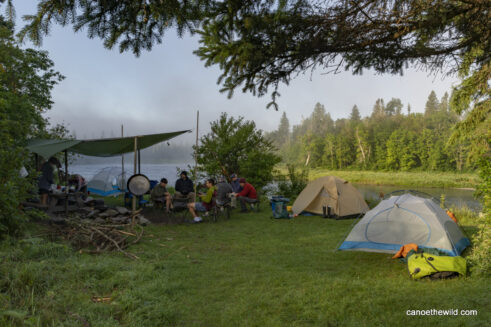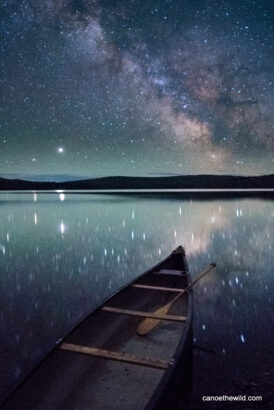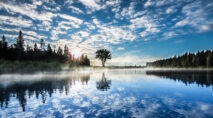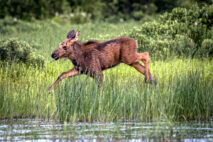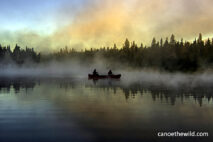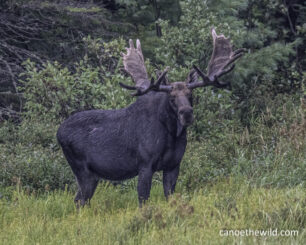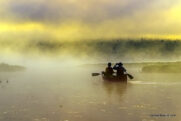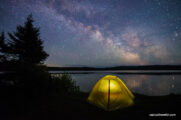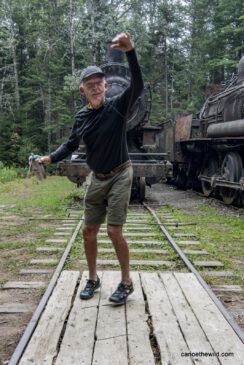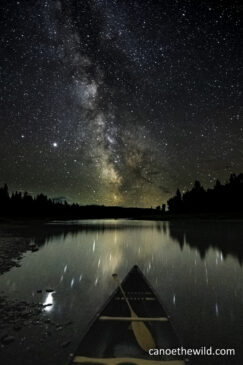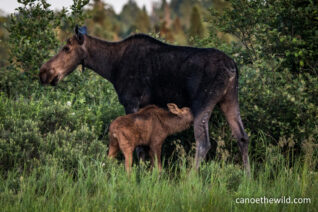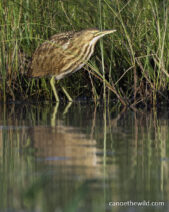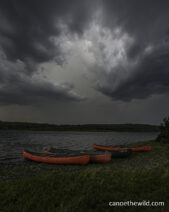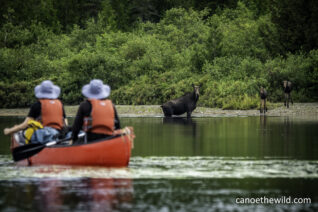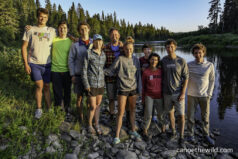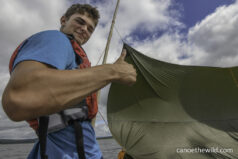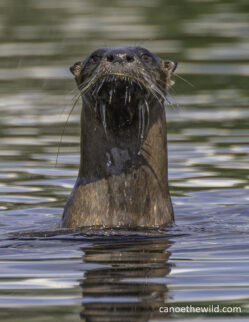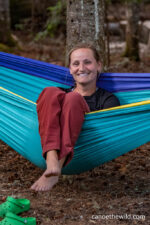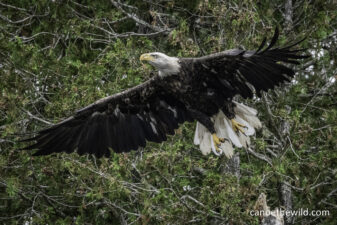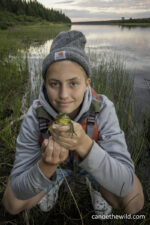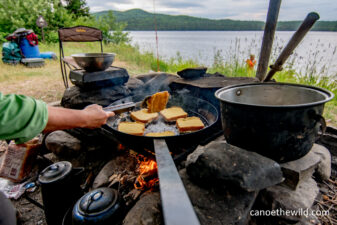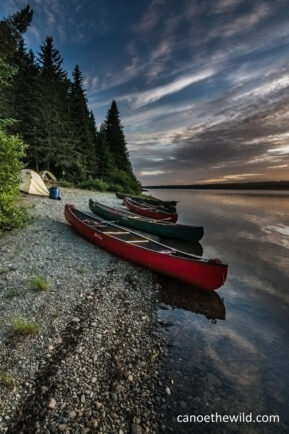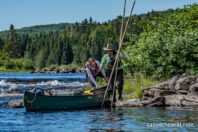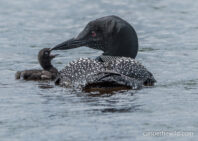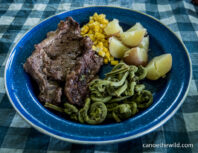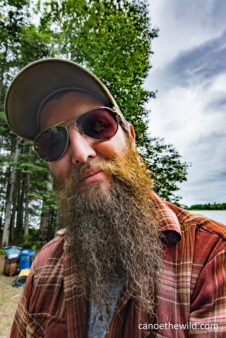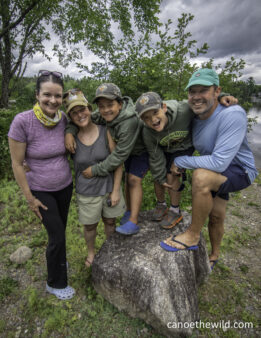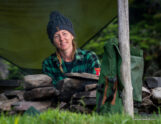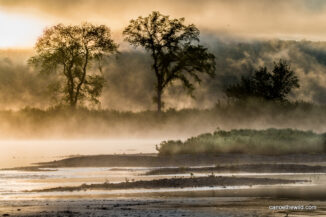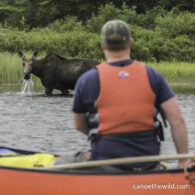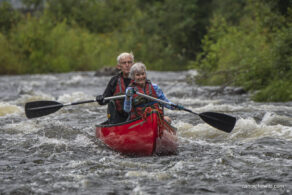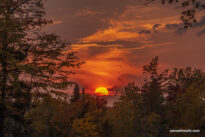Another Canoe the Wild 5 day canoe trip, this one for the Allagash Wilderness Waterway Foundation YOTA, Youth On The Allagash program. The outing involved paddling over 40 miles, setting up and taking down camp, hearing from a park ranger about his seasonal job, exploring the logging museum at Churchill Dam, reading from the AWWF Explorer booklet, learning to be good stewards of the environment, taking on leadership roles, meal preparation, cooking over an open fire, canoe poling, whitewater canoeing, Students also learned about career opportunities as a Maine guide and had fun with a moose calling contest! and more. See our schedule here
Maine guide
Moose and Wildlife Photography Outing, June 24-28, 2024
A wildlife and moose photography outing at a remote Maine lake. Late June is prime time for moose viewing. Last season we spotted over 20 moose on the lake and tributaries and the area was teaming with birds and other wildlife. We used Old Town Canoe solo Loon Angler 126 kayaks and paddled in small groups both early morning and late afternoon into the evenings. Accommodations include staying in one of 2 cabins or you can bring your own tent if you prefer. With new cuts on nearby ridges resulting in more feed, we expect to see the moose population in this area. Physical requirements involve getting in and out of a kayak and paddling around the small lake up to 1.5 miles and back. Note, pictures below are from last season’s outing and other previous outings at this location. Photo credits Dave Conley and Laura Zamfirescu. Next outing is scheduled for June of 2025
7 Day Allagash Trip, August 14-20, 2022
Acton MA Scout Troop 32 with Canoe the Wild on a week long canoe trip down the Allagash. Canoe the Wild offers custom private trips for your family or group.
Photography Tips for Your Next Canoe Trip
PHOTOGRAPHY TIPS FOR YOUR NEXT CANOE TRIP
By: Dave Conley
As a full-time professional guide, I spend most of my time in the woods and water. Through experience spent outdoors, I have cultivated another passion: photography.
Because of what I do, I have ample opportunities to observe nature, wildlife, and the connection people have with the outdoors and each other. I enjoy capturing the feel of the wilderness experience, telling the story through images. After all, once the trip is over, photographs are an excellent way to preserve unforgettable memories and share your experience with others.
Whether you’re an aspiring wildlife or landscape photographer or an amateur with a camera looking for helpful tips to enhance your final product, I’d like to offer some helpful advice and guidance from my years of experience outside with a camera.
CAPTURING EMOTION
Emotion is a powerful communicator. It conveys what a person may be feeling but also tells a story. I enjoy capturing images of people having a good time. On adventure trips, this tends to be relatively easy in the evenings while relaxing in camp after dinner, reliving the experiences of the day together. Maybe even over a game of cards near the campfire. Keep that camera handy to capture these special, candid moments.

ACTION SHOTS AND MANUAL MODE
When my clients are looking for an action-packed wilderness canoe trip, a few trips spring to mind. Both in Quebec, the NE Mistassibi River and the Bonaventure River feature numerous Class II-III rapids, ledge drops, and gorges. In my home state of Maine, Little Falls on the St. Croix River and Chase Stream Rapids on the Allagash take the cake. These are great places to capture action and expression at the same time.
Expressions captured while navigating an action-filled portion of a river may show fear, concentration, or excitement! To capture emotions at just the right time with your camera, shooting position is critical.
For example, At Chase Stream Rapids on the Allagash, I paddle the first set of rapids first, positioning myself at the bottom of the rapid. I ask the paddlers to give me 5 minutes to navigate the rapids and get set up for the shot. I situate myself low to the water with the sun behind me. I set the camera in Manual mode and control shutter speed, aperture, and ISO settings. The camera’s lens aperture (f-stop) a few clicks above the widest opening allows for more depth-of-field when focusing.
With my Nikon 80-400mm lens, setting the f-stop to 7.1 provides a greater depth of field, allowing both of the paddlers in the canoe to come into focus.
It’s always about allowing enough light to enter the camera to capture the image, a balancing act between shutter speed, ISO, and aperture. A fast shutter speed is necessary to stop action, but in low light conditions, a fast shutter speed may not allow enough light in. Having the aperture wide open (lowest number) may not give enough depth of field to have both the stern and bow partners in focus. If you introduce too much artificial light (ISO), you’ll end up with too much noise. My goal is to keep both paddlers in focus, so I try to get away with the slowest shutter speed and the widest aperture to stop action.
I avoid photographing mid-day, as the light tends to be less contrasted (shadows), resulting in less exciting images. In the picture below, while paddling an Old Town Discovery 169 canoe, it was approaching midday but had the advantage of tall fir trees on either side of the river, which diffused light.

CAMERA EQUIPMENT
Cameras have come a long way in a few short years. From affordable point-and-shoot cameras to DSLRs to mirrorless cameras, options are endless. What you choose will depend mainly on your budget, skill level, and your appetite to learn and grow as a photographer.
Mirrorless cameras, such as the Sony A7, are more expensive, but there are many advantages. Mirrorless camera technology is new, offering high mega-pixels and better low light shooting capabilities, allowing for faster shutter speeds in low light situations stopping action resulting in a much better finished product. In post-production, editing images captured on a mirrorless will have less noise and greater cropping capabilities. And the video quality is fantastic as well.
Maybe you’re new to photography and don’t want to break the bank. There are many good point-and-shoot cameras on the market. Out-of-the-box, point-and-shoot cameras are set up to capture decent images without the need to mess with the settings. Many feature tilt displays where you can see the impact of your adjustments before you press the shutter button. If you are adventurous and want to experiment with your camera settings, turn off the automatic (A) mode. Try shooting in aperture priority or auto-ISO where you only control two of the functions, not all three at once.
Photography is like playing an instrument. It’s one thing to have superior equipment. It’s another to know how to use it. Nothing substitutes for good old-fashioned practice.
FIRST AND LAST LIGHT & A BIG BULL MOOSE
During the summer of 2020, while guiding canoe trips for first-timers on the Allagash, I spotted over 80 moose. Some moose were at a distance while others were up close, seemingly without a care in the world. We spotted several along the trip route. Others at first light or late afternoons, while taking short paddles to known moose habitat where we watched on as they fed on aquatic vegetation in the water.

Photography is all about lighting and subject matter. Dawn and dusk offer some of the best light and are also the best time to capture wildlife images as animals are most active at first and last light.
Last summer, while guiding my 8th Allagash canoe trip, I was greeted by fellow guide Wayne Daggett while exiting my tent early in the morning. He told me there was a moose in the marsh across from the campsite. I didn’t give it much thought as I worked my way to the campfire to put the coffee on. Once my eyes adjusted, I could see the moose and noticed it was a big bull! Despite all of the moose sightings all summer, I hadn’t seen many big bulls. I abandoned my coffee duties opting instead to grab my camera and tripod. As dawn gave way and the light increased, so did the ability to shoot with a higher shutter speed and lower ISO, producing a better-quality image.

NIGHTTIME & SETTINGS
Many years ago, I guided a group of high school students from China on the St. Croix River. On the first night, the students stood on the shore staring into the night sky, amazed at how many stars they could see. They spoke about how the pollution (light and environmental) in China had kept them from experiencing the night sky like this before.
Remote wilderness trips such as the Allagash, Bonaventure, and NE Mistiassibi Rivers are entirely free of light pollution, providing excellent opportunities to take nighttime shots, including shots of the Milky Way and northern lights.
When taking pictures of the Milky Way, a clear night with a new moon is best. You’ll need a tripod. Turn your camera’s autofocus off and adjust to infinity and use the delayed shutter button. Be sure your framing includes an interesting foreground, such as an Old Town canoe. Another option is to use photo stacking, which involves taking two photos, layering them together in post-production editing. To photo stack, manually focus on the foreground in the first image, careful not to move your tripod. Focus on a distant point in the second image. For nighttime photography, set focus to infinity, expose for 30 seconds or less, ISO of 6400, aperture wide open.

CAPTURING WILDLIFE ON THE MOVE
While on a canoe trip, you’ll spend much of the time paddling, and it is a great time to capture wildlife images. Most often, especially with birds, you’ll have to act quickly to capture an image. You never know what lies beyond the next bend, so keep your camera close. I can’t tell you how many times I have rounded the bend to find a moose in the river within close proximity. That is why my waterproof case is always handy, with my camera and zoom lens (Nikon lens 80mm-400mm, 4.5-5.6).
So that my camera is ready to capture wildlife on the fly, I keep my settings on auto ISO and the aperture (f-stop) set to the lowest number. I put the camera to burst mode (ten frames per second), and the camera focus to continuous, which helps track a moving animal or bird. With these settings, all I need to do is adjust the shutter speed and begin shooting.

THE EYES HAVE IT
When photographing wildlife, always focus your camera on the eye while facing or broadside. It sure does make a better picture than their backside as they depart.


WEATHER
Even though we all long for a crystal clear day without a cloud in the sky, days like that tend to manufacture boring photos. Too much blue sky in an image can be uninteresting – kind of like a blank canvas before an artist applies paint to it. Clouds provide texture and depth, also helping to diffuse or filter light. I love photographing fog rising off the water and approaching and departing storm systems. Instances like this provide some of the best photography conditions.


SCENERY & LANDSCAPE SHOTS
I prefer campsites that offer incredible wilderness scenery and opportunities for wildlife viewing. Since the best photography conditions exist early or late in the day, choosing the proper campsites should be strategic for serious or aspiring photographers. Plan to get up before sunrise and have your tripod ready. And if the forecast calls for a drop in temperature overnight, you can count on fog banks and great photography opportunities. When framing your subject, keep the rule of 3rds in mind. Avoiding straight lines, look for an interesting subject such as a mountain or a canoe, and utilize interesting light conditions.

AFTER THE TRIP & SHOOTING IN RAW
Years ago, while guiding a moose photography trip during the moose rut in the fall for a seasoned photographer, he encouraged me to move away from shooting in JPEG format. Instead, he suggested that I switch to photographing in RAW format. He explained that the RAW format offers the photographer enhanced editing capabilities in post-editing. I am glad I took his advice, as it has improved my final product. When taking pictures in raw format, all the essential elements such as exposure, highlight, contrast, color, sharpening, etc., are unlocked, offering a full range of post-editing options.
PHOTOGRAPHY WORKSHOPS AND CANOE THE WILD
In partnership with Ben Williamson of Downeast Magazine, Canoe the Wild offers a 4-day photography workshop on the Allagash River each summer. Though 2021 is already full, we are planning two additional workshops in 2022. To discuss photography, book a canoe trip, or secure a spot in the next photography workshop, shoot me an email or give me a call. I am glad to answer any questions you may have.
—
Dave Conley, is an accomplished Maine guide and owner of Canoe the Wild. He lives in Danforth, Maine, and loves wilderness tripping and photography. Follow Dave on Instagram @canoethewild or visit his website www.canoethewild.com
Tammi Matula, Environmental Education Change Maker
Shared from the Maine Environmental Education Association Blog Post 02/03/2021
This week we’re featuring Tammi Matula from the East Grand School (EGS) in Danforth, ME! Tammi is a Pre-K through grade 12 physical education teacher who also co-teaches EGS’ Outdoor Education (OE) program. As part of MEEA’s Mini-Grant for Outdoor Learning Program, Tammi received funding to grow the pre-existing fleet of bikes that the students maintain as part of their OE programming.
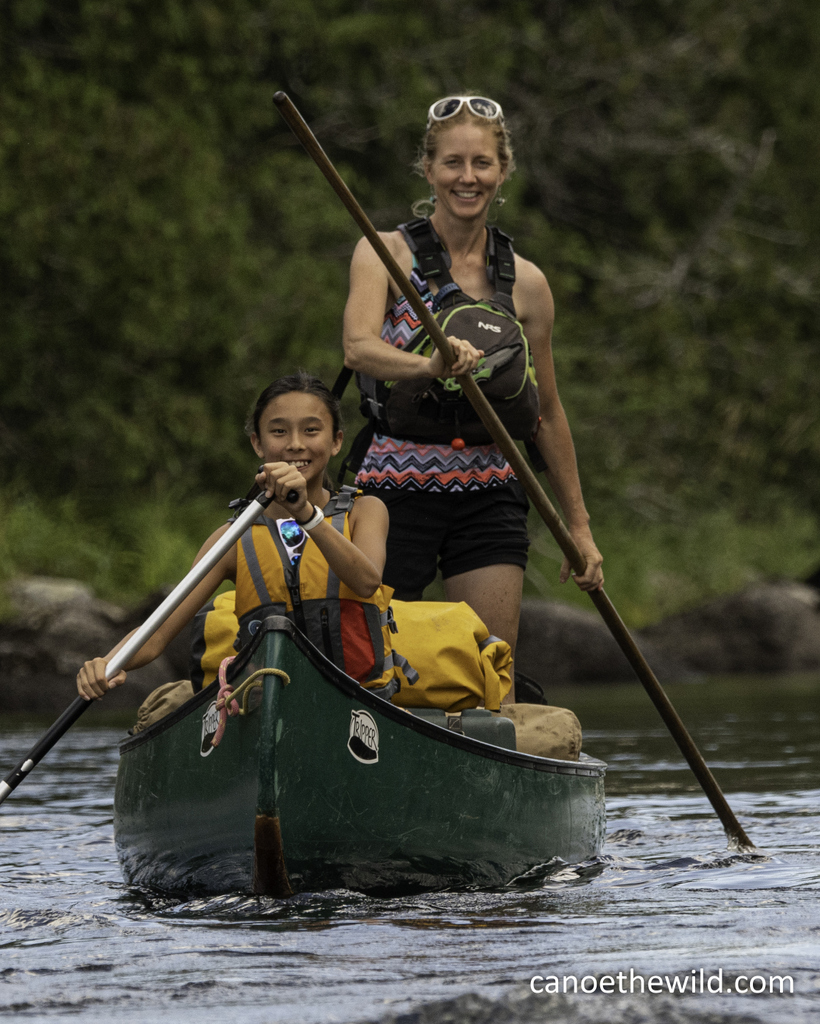
East Grand’s focus on outdoor learning has been supported on many fronts. Over the years, the school incorporated outdoor education into the foundation of the curriculum. Curriculum development was facilitated and supported by Rural Aspirations and TimberNook who helped build and enhance a new curriculum that was focused on the outdoors and supported teachers with the transition to teaching outside. With support for outdoor learning from the principal, East Grand was able to attract more teachers interested in outdoor education, like Tammi. One of the key supporters of East Grand’s shift to an outdoor focus was (and still is!) the local grassroots group, Citizens Organization for Rural Education (CORE). When the school risked closure, CORE community members worked with the school administration to incorporate local nature-based resources into the school’s mission.
Tammi shared that the emphasis that COVID-19 placed on outdoor learning has provided her the opportunity to expand what her students can learn through outdoor education. One of the benefits that Tammi shared was fostering a sense of achievement. Students can get discouraged when they don’t achieve standard measures of success in the traditional classroom, but the lessons taught in outdoor spaces have more space for experimentation and different measures of success. Tammi related that activities like knot-tying were difficult for some students, but the confidence they gained once they made a breakthrough bolstered their confidence in other areas.
“Education can be tricky, because sometimes it doesn’t feel like real life, but now it feels like real life”
Being prepared for outdoor learning is a challenge that teachers at EGS are still addressing, especially when it comes to having the right equipment and equitable access to gear for students. On some fronts, this challenge has become an opportunity for students to learn lessons and preparedness. Tammi related that getting stuff ready and together for outdoor classrooms can be a challenge, but when the students take charge of tasks, they learn to take responsibility and begin to understand delegation. Tammi underscored that “education can be tricky because sometimes it doesn’t feel like real life, but now it feels like real life.” In this way, the skills they learn in these outdoor settings become practical.
Tammi shared that East Grand has plans to continue expanding their outdoor learning to include a hard outdoor skills program for students in 3rd grade and up; in hopes of building their confidence and extending their learning into the surrounding community. The school’s success makes them a great model for other schools interested in outdoor learning. Tammi suggested a few key pieces you could consider if your school is looking to do outdoor learning: securing board and admin support to incorporate outdoor learning, consulting with outdoor educators and community partners, connecting with nearby resources (like local trails), delegating staff time, and having patience (sustainable outdoor programming takes time!).
Dave’s Favorite Pictures from 2020
A look back at the 2020 Maine canoe trip season While we had a late start due to Covid restrictions, it ended up being a really great season! During the month of June, Maine landscape photographer Ben Williamson of Downeast Magazine and his brother Zander joined us on a 5 day Allagash canoe trip. Zander caught lots of trout while Ben worked with me on improving my photography skills. Jeremy Grant of The Timber Cross joined us in July on an Allagash trip putting a high end video together, we spotted 23 moose and Jeremy captured some real cool drone footage (with a special permit). From late July into September, Canoe the Wild guides were busy on numerous Allagash and St. Croix River canoe trips. Moose hunting season went very well and we have posted some scenic shots below. Bookings are coming in almost daily now and we’re looking forward to what summer 2021 brings. We hope to be back in Eastern Canada on the Bonaventure week long whitewater trip but it not, we’ll enjoy Maine rivers such as the St. Croix River, Allagash Wilderness Waterway, the St. John River and West Branch of the Penobscot Rivers if the interest is there. Check out our 2021 Canoe the Wild schedule and remember, if a trip doesn’t happen due to Covid, your deposits are refundable. To book a trip, please visit our website or contact Dave Conley for any questions you may have. Hope to see you in 2021
